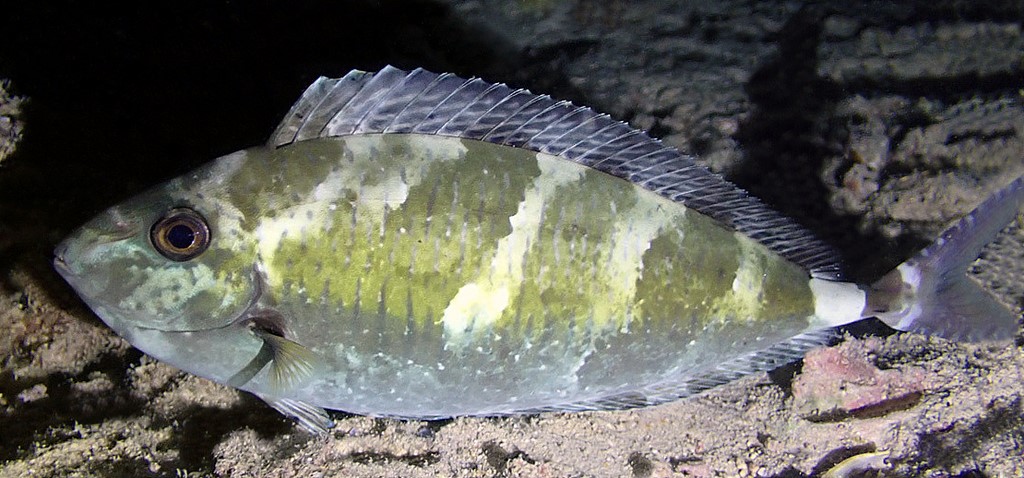NASO THYNNOIDES - (CUVIER, 1829)
Picture courtesy of: Johan Bas
Actinopterygii (Gigaclass) > Actinopteri (Class) > Teleostei (Subclass) > Acanthuriformes (Order) > Acanthuridae (Family) > Naso (Genus)
Nason à une épine, Onespine unicornfish, Single-spined unicornfish, Barred unicornfish, One-spine unicorn, Oneknife unicornfish, Little unicorn, Singlespine unicornfish, Rufia quilhada, Eenmes-eenhoringvis, Bôzuhagi, ボウズハギ 倒吊, 单板盾尾鱼,
Synonymes
Axinurus thynnoides (Cuvier, 1829)
Naso thynoides (Cuvier, 1829)
-------------------------
Description
Dorsal spines (total): 4-5 (usually: 4); Dorsal soft rays (total): 28-30; Anal spines: 2; Anal soft rays: 28-30. Pectoral fin rays: 16-18; Pelvic fin rays: I, 3; Anterior gill rakers: 13-16; Adults with 80-90 upper teeth, 70-80 lower teeth. Body depth: 2.8-3.2 in SL; Head length: 4.05-4.2 in SL. Dorsal profile of head convex, without any bony protuberance, and interorbital space broad and flat; Oblique groove on snout below nostrils, reaching half way from eyes to mouth; Single peduncle plate, keel small and approximately semicircular; Caudal fin emarginate. Max. length: 40.0 cm FL, common length: 25.0 cm FL. Depth range: 2 - 40 m, usually 10 - 35 m.
Color
Body grey, paler ventrally; About 30 narrow bluish grey vertical bars on body, becoming tiny irregular spots on head; Diffuse yellow band across midsides; Peduncle plate and keel dusky; Caudal fin bluish grey.
Etymology
Naso: from Latin, nasus = nose. Referring to “protuberance in the shape of a horn or a large magnifying glass on the nose” (translation, actually forehead) on adults of Naso fronticornis (= unicornis).
thynnoides: from Latin, thynnus or from Greek, thunnos = Tuna + from Latin suffix, -oides = similar to. Referring to its more elongate and compressed form, roughly similar to that of a tuna (per Valenciennes 1835).
Original description: Axinurus thynnoides Cuvier, 1829 - Type locality: Dorey harbor, Papua New Guinea.
Distribution
Indo-West Pacific: East Africa, Socotra (Yemen), Seychelles, Comoros and western Mascarenes (La Réunion, Mauritius), east to Caroline Islands (Micronesia), north to Ryukyu Islands (Japan), south to Queensland (Australia) and New Caledonia.
Biology
Generally uncommon species found in steep outer lagoon and seaward reef slopes. Occurs singly or in large schools. Usually seen swimming steadily along upper edges of drop-offs in pursuit of plankton. A semi-pelagic fish that feeds on zooplankton, but remains over or near reefs. Also feeds on algae. It is cleaned by Labroides and sleeps on reefs at night, taking on a disruptive mottled pattern. Caught with nets.
Last update: 5, May 2024
Actinopterygii (Gigaclass) > Actinopteri (Class) > Teleostei (Subclass) > Acanthuriformes (Order) > Acanthuridae (Family) > Naso (Genus)
Nason à une épine, Onespine unicornfish, Single-spined unicornfish, Barred unicornfish, One-spine unicorn, Oneknife unicornfish, Little unicorn, Singlespine unicornfish, Rufia quilhada, Eenmes-eenhoringvis, Bôzuhagi, ボウズハギ 倒吊, 单板盾尾鱼,
Synonymes
Axinurus thynnoides (Cuvier, 1829)
Naso thynoides (Cuvier, 1829)
-------------------------
Description
Dorsal spines (total): 4-5 (usually: 4); Dorsal soft rays (total): 28-30; Anal spines: 2; Anal soft rays: 28-30. Pectoral fin rays: 16-18; Pelvic fin rays: I, 3; Anterior gill rakers: 13-16; Adults with 80-90 upper teeth, 70-80 lower teeth. Body depth: 2.8-3.2 in SL; Head length: 4.05-4.2 in SL. Dorsal profile of head convex, without any bony protuberance, and interorbital space broad and flat; Oblique groove on snout below nostrils, reaching half way from eyes to mouth; Single peduncle plate, keel small and approximately semicircular; Caudal fin emarginate. Max. length: 40.0 cm FL, common length: 25.0 cm FL. Depth range: 2 - 40 m, usually 10 - 35 m.
Color
Body grey, paler ventrally; About 30 narrow bluish grey vertical bars on body, becoming tiny irregular spots on head; Diffuse yellow band across midsides; Peduncle plate and keel dusky; Caudal fin bluish grey.
Etymology
Naso: from Latin, nasus = nose. Referring to “protuberance in the shape of a horn or a large magnifying glass on the nose” (translation, actually forehead) on adults of Naso fronticornis (= unicornis).
thynnoides: from Latin, thynnus or from Greek, thunnos = Tuna + from Latin suffix, -oides = similar to. Referring to its more elongate and compressed form, roughly similar to that of a tuna (per Valenciennes 1835).
Original description: Axinurus thynnoides Cuvier, 1829 - Type locality: Dorey harbor, Papua New Guinea.
Distribution
Indo-West Pacific: East Africa, Socotra (Yemen), Seychelles, Comoros and western Mascarenes (La Réunion, Mauritius), east to Caroline Islands (Micronesia), north to Ryukyu Islands (Japan), south to Queensland (Australia) and New Caledonia.
Biology
Generally uncommon species found in steep outer lagoon and seaward reef slopes. Occurs singly or in large schools. Usually seen swimming steadily along upper edges of drop-offs in pursuit of plankton. A semi-pelagic fish that feeds on zooplankton, but remains over or near reefs. Also feeds on algae. It is cleaned by Labroides and sleeps on reefs at night, taking on a disruptive mottled pattern. Caught with nets.
Last update: 5, May 2024
